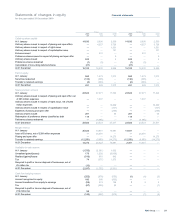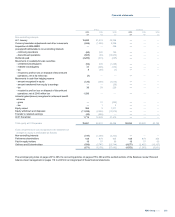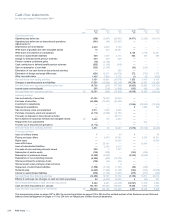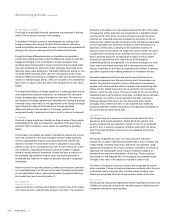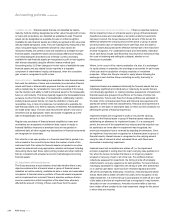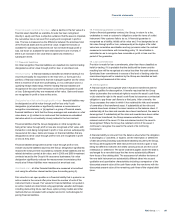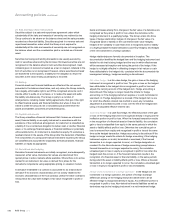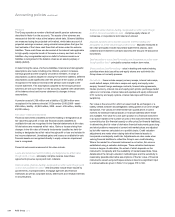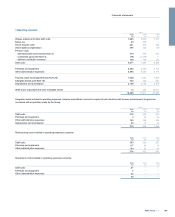RBS 2010 Annual Report Download - page 282
Download and view the complete annual report
Please find page 282 of the 2010 RBS annual report below. You can navigate through the pages in the report by either clicking on the pages listed below, or by using the keyword search tool below to find specific information within the annual report.Available-for-sale - financial assets that are not classified as held-to-
maturity; held-for-trading; designated as at fair value through profit or loss;
or loans and receivables, are classified as available-for-sale. Financial
assets can be designated as available-for-sale on initial recognition.
Available-for-sale financial assets are initially recognised at fair value plus
directly related transaction costs. They are subsequently measured at fair
value. Unquoted equity investments whose fair value cannot be
measured reliably are carried at cost and classified as available-for-sale
financial assets. Impairment losses and exchange differences resulting
from retranslating the amortised cost of foreign currency monetary
available-for-sale financial assets are recognised in profit or loss together
with interest calculated using the effective interest method (see
Accounting policy 3). Other changes in the fair value of available-for-sale
financial assetsand any related tax are reported in a separate
component of shareholders' equity until disposal, when the cumulative
gain or loss is recognised in profit or loss.
Reclassifications - held-for-trading and available-for-sale financial assets
that meet the definition of loans and receivables (non-derivative financial
assets with fixed or determinable payments that are not quoted in an
active market) may be reclassified to loans and receivables if the Group
has the intention and ability to hold the financial asset for the foreseeable
future or until maturity. The Group typically regards the foreseeable future
as twelve months from the date of reclassification. Additionally, held-for-
trading financial assets that do not meet the definition of loans and
receivables may, in rare circumstances, be transferred to available-for-
sale financial assets or to held-to-maturity investments. Reclassifications
are made at fair value. This fair value becomes the asset's new cost or
amortised cost as appropriate. Gains and losses recognised up to the
date of reclassification are not reversed.
Regular way purchases of financial assets classified as loans and
receivables are recognised on settlement date; issues of equity or
financial liabilities measured at amortised cost are recognised on
settlement date; all other regular way transactions in financial instruments
are recognised on trade date.
Fair value for a net open position in a financial asset that is quoted in an
active market is the current bid price times the number of units of the
instrument held. Fair values for financial assets not quoted in an active
market are determined using appropriate valuation techniques including
discounting future cash flows, option pricing models and other methods
that are consistent with accepted economic methodologies for pricing
financial assets.
16. Impairment of financial assets
The Group assesses at each balance sheet date whether there is any
objective evidence that a financial asset or group of financial assets
classified as held-to-maturity, available-for-sale or loans and receivables
is impaired. A financial asset or portfolio of financial assets is impaired
and an impairment loss incurred if there is objective evidence that an
event or events since initial recognition of the asset have adversely
affected the amount or timing of future cash flows from the asset.
Financial assets carried at amortised cost - if there is objective evidence
that an impairment loss on a financial asset or group of financial assets
classified as loans and receivables or as held-to-maturity investments
has been incurred, the Group measures the amount of the loss as the
difference between the carrying amount of the asset or group of assets
and the present value of estimated future cash flows from the asset or
group of assets discounted at the effective interest rate of the instrument
at initial recognition. For collateralised loans and receivables, estimated
future cash flows include cash flows that may result from foreclosure less
the costs of obtaining and selling the collateral, whether or not
foreclosure is probable.
Where, in the course of the orderly realisation of a loan, it is exchanged
for equity shares or properties, the exchange is accounted for as the sale
of the loan and the acquisition of equity securities or investment
properties. Where the Group’s interest in equity shares following the
exchange is such that the Group controlling an entity, that entity is
consolidated.
Impairment losses are assessed individually for financial assets that are
individually significant and individually or collectively for assets that are
not individually significant. In making collective assessment of impairment,
financial assets are grouped into portfolios on the basis of similar risk
characteristics. Future cash flows from these portfolios are estimated on
the basis of the contractual cash flows and historical loss experience for
assets with similar credit risk characteristics. Historical loss experience is
adjusted, on the basis of observable data, to reflect current conditions not
affecting the period of historical experience.
Impairment losses are recognised in profit or loss and the carrying
amount of the financial asset or group of financial assets reduced by
establishing an allowance for impairment losses. If, in a subsequent
period, the amount of the impairment loss reduces and the reduction can
be ascribed to an event after the impairment was recognised, the
previously recognised loss is reversed by adjusting the allowance. Once
an impairment loss has been recognised on a financial asset or group of
financial assets, interest income is recognised on the carrying amount
using the rate of interest at which estimated future cash flows were
discounted in measuring impairment.
Impaired loans and receivables are written off, i.e. the impairment
provision is applied in writing down the loan's carrying value partially or in
full, when the Group concludes that there is no longer any realistic
prospect of recovery of part or all of the loan. For portfolios that are
collectively assessed for impairment, the timing of write off principally
reflects historic recovery experience for each portfolio. For loans that are
individually assessed for impairment, the timing of write off is determined
on a case-by-case basis. Such loans are reviewed regularly and write
offs will be prompted by bankruptcy, insolvency, restructuring and similar
events. Most debt is written off within five years of the recognition of the
initial impairment. It is not the Group’s usual practice to write-off all or part
of the asset at the time an impairment loss is recognised; it may however,
take place in rare circumstances. Amounts recovered after a loan has
been written off are credited to the loan impairment charge for the period
in which they are received.
RBS Group 2010280
Accounting policies continued



